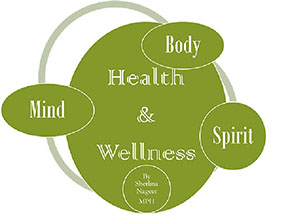Introduction
Starting today, Stabroek News will publish a biweekly column by Sherlina Nageer on various wellness-related issues, including sexual, reproductive, women, and children’s health, nutrition, primary health care, alternative and traditional medicine, chronic diseases, as well as issues around training, monitoring and evaluation, health policy and education among other areas.

Unfortunately, many people in Guyana are still not properly informed about mental health and there is still a great deal of stigma and discrimination against persons suffering from mental illness. The common perception of ‘mad people’ that many Guyanese have is of deranged individuals, homeless, wandering the streets in various states of undress, mumbling to themselves, and sometimes threatening passersby. While this is indeed true for a portion of the mentally ill, the fact is that such persons are not representative of the majority of those suffering from mental illness. In fact, most people who suffer from mental illness are still able to be productive members of society, to engage in meaningful relationships with others, and to successfully accomplish their life goals.
Mental illness is just that – illness that affects the mind and emotional processes. (Remember however, that the mind and body are connected and ailments of the mind often result in physical maladies). Most people who suffer from mental illness are ‘ordinary’ in other ways- with homes, jobs and families. Most are not violent or dangerous to others. In fact, mental illness is extremely common, with over a third of the population of most countries affected in some way, according to the World Health Organisation.
There is a wide range of conditions which comprise mental illness, from depression, anxiety, and panic attacks to schizophrenia, dementia, and psychosis. These manifest in varying levels of severity, with each individual being affected differently, and also with the same person sometimes being affected differently at different times. In addition, one individual can suffer from more than one condition, at either the same or a different time. It may sound confusing and that is because this is a complex topic.
There is much that is still not well known about mental illness, and like many other diseases it is an area in which a great deal of research is still being conducted. Like many other illnesses, there is no single cause; instead there is a combination of biological and environmental factors which interact to cause disorder. There is a genetic component which can predispose or make individuals more sensitive to mental illness if other family members are affected (just like some people have a family history of heart disease or diabetes, for example).
However, the environmental aspects are also enormously influential, with the food eaten, the chemicals we are exposed to, the amount of stress in our lives, playing a hugely significant role in whether or not, as well as to what extent, persons are affected. In fact, some contend that these external influences are the determining factors, with the very things which are sometimes used as yardsticks of ‘development’ and progress being the same things which end up making people sick.
Scientific uncertainty aside, the fact is that most of us are impacted by mental illness. We are either suffering ourselves, or we have friends or family members who are affected.
It is important to better understand this issue, as well as to become more comfortable in speaking openly and non-judgmentally about this topic, in order to reduce the associated stigma and discrimination, and to help the persons who are affected—including ourselves and our loved ones—to receive better and more compassionate care.
Some people may require medication while others may also need counselling and to be in a supportive environment, with understanding friends and family members. Some may require a combination of medication and counselling, while others may need to make changes in their life to increase their well-being, for example by leaving unhealthy relationships, stressful employment or other situations, trying a new diet or exercise regime, or engaging in more meaningful activities. The point is that there is no ‘magic bullet’ solution for mental illness, it is a complex issue which affects each person differently and multiple actions may be required.
Understanding the complexity of mental illness is also key to gaining greater insight into other troubling aspects of Guyanese society. Societal problems such as interpersonal violence, substance abuse, and suicide, as well as physical maladies such as high blood pressure, obesity, and heart disease, often have some unacknowledged and/or untreated mental disorder as a root cause. Realising these connections can lead to the development of more holistic treatment and intervention programmes with better chances of success than those that currently exist.
My grandmother Gulshan died long before I was born; I never knew her. I tell her story now though, in an attempt to shine some light into the darkness that affected her life, and that, unfortunately, still affects far too many Guyanese. The health care system of Guyana is still woefully incapable of providing proper quality care to the mentally ill and vulnerable. There is still a severe shortage of mental health professionals on staff in the public health care system, fewer than a half dozen for the entire population.
Most Guyanese who suffer from mental illness, especially those who are afflicted by the more severe forms of the disease, who do not have the economic means to access private care, and who lack supportive families, are indeed left to wander the streets, abandoned like strays. Others are warehoused in institutions of subpar quality. Yet others—especially the youth—drive suicide to epidemic proportions. We need to do much better; we cannot continue to ignore this issue. Every Guyanese has a role to play, from increasing individual awareness, building more supportive communities and healthier environments, to advocating for better quality mental health care in the public health system.




